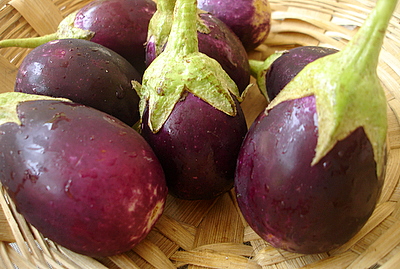
Crop: Brinjal
Scientific name : Solanum memongena (Lin.)
Common / Local Name : Egg plant/Vaingan (Konkani)
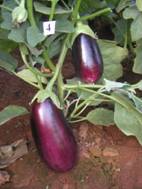
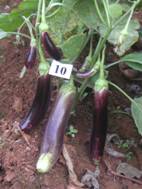
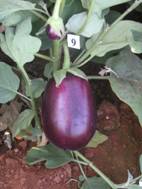
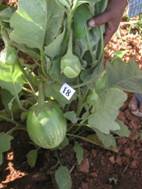
Brinjal is one the most common tropical vegetables grown in India. A large number of cultivars differing in size, shape and colour of fruits are grown in India. Immature fruits are used in curries and varieties of dishes are prepared out of brinjal. Fruits are moderate sources of vitamins and minerals like phosphorous, calcium and iron and nutritive value varies from variety to variety.
Brinjal is a hardy crop and cultivated under a wide range of soils. Soil should be prepared to a fine tilth by 2-3 ploughings. FYM should be incorporated in soil at the time of final ploughing. Seedlings are transplanted in levelled land in plots of convenient size for irrigation.
Seeds are sown in nursery bed and transplanted to main field after four weeks when it is 8-10cm tall. Depending on growth of varieties and seasons of cultivation, 300-500g seeds are required for one hectare of planting.
Taleigao: Taleigao type produce violet, round fruits, the average fruit weight being 350g and per plant yield about 1.5-2.0 kg. The flesh is hard in Taleigao, which accounts to longer shelf life.
Agassaim: produces violet- purple, elongated fruit of 300g and gives about 2-2.5kg fruits/plant. The Agassaim type has soft and puffy flesh. Both the above varieties are susceptible to bacterial wilt disease.
Surya: Produces small purple fruits of oval in shape each weighing around 60-80g with a plant yield of 1.5kg. Resistant to bacterial wilt.
Swetha: Small white elongated fruits weighing around 80-110g with a single plant yield of 1.5-2.0 kg. Resistant to bacterial wilt.
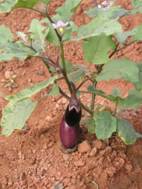
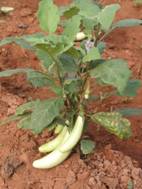
Brinjal is a long duration crop with high yield potential. Higher fertility levels and better soil conditions have significant and positive effect on productivity. Under normal soil, 150kg N and 100kg P2O5 is optimum. For a balanced nutrition, 30-60kg K2O is included in fertilizer package of brinjal in most the states. 1/3N, full P and full K should be applied as basal dose and remaining N in two split does at 25days and 45 days after transplanting.
Timely irrigation is essential especially for fruit set and development. The irrigation is required at every third /4th day during summer while in winter, it should be 7-8 days interval. For row planted crop, drip irrigation is advantageous and fertilizer can be supplied through drip irrigation.
It is essential to keep the field free of weeds especially at initial stages of crop growth and usually done by 2-3 light hoeing or earthing up. This facilitates better aeration to root system and gives support to plants.
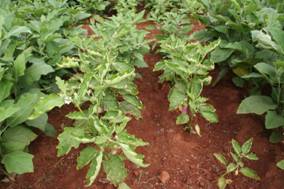
Fruit and shoot borer: The larvae bore into tender parts causing drooping of young shoots and rotting of fruits. Affected plants parts should be removed along with larvae and destroyed.
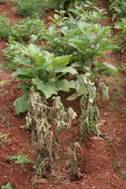
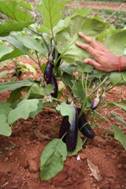
Disease management:
Bacterial wilt: Disease results in sudden wilting and drying up of plants. Plants are more affected during pre flowering and early fruiting stages. Grow resistant varieties like Surya, Swetha, Utkal Madhuri, Arka Nidhi etc.
Introduction
Goa is a coastal state, situated along the Konkan track bounded by Arabian Sea and States of Karnataka and Maharashtra. Cultivation of vegetables is carried out mainly during the rabi season, after harvest of paddy. Among the vegetables, brinjal finds an important place in the cultivation. Though high variability exists in brinjal, a local cultivar “Agassaim? is the preferred one because of high flesh, less seeds and bigger fruit size (Plate 1). The brinjal cultivation in Goa is mainly affected by bacterial wilt (BW) and is a major production constraint. The local preferred cultivar, Agassaim is highly susceptible to BW (Plate 2) and the incidence ranges from 30-100 per cent during rabi.
This pathogen has a wide host range of more than 200 plant species which makes its management difficult. Other than chemical fumigants, there is no commercial pesticide available for the control of BW. Conventional management strategies like crop rotation, date of planting, other cultural methods and soil treatment are not very effective. Resistant cultivars are limited to locations, climate and to the strains of the pathogen. Only a few varieties show stable resistance but are not generally preferred by the growers. Recent studies have indicated that biological control of BW could be a sustainable and eco-friendly strategy. As there is no single effective control measure available for BW, integrating different methods is a must.
The objective of this technical brochure is to provide information to farmers/extension agencies on implementation of integrated management strategy for brinjal BW. Here the discussion focuses on the pathogen, host range, favorable condition, diagnosis and management of BW in order to minimize the loss caused by the disease.
About the disease
The pathogen
Bacterial wilt in brinjal is caused by Ralstonia solanacearum, a soil bacterium, formerly known as Pseudomonas solanacearum. The pathogen has five different races, each infecting different plant species. R. solanacearum strains are grouped into five biovars based on the biochemical tests. Brinjal BW is mostly caused by strains belonging to race 1 and biovars 3. Race 1 has wide host range including solanaceous vegetables like tomato and chilli. Race 1 strains from Goa exhibits genetic variability and difference in virulence on brinjal.
Host range and distribution
R. solanacearum is a widely distributed pathogen found in tropical, subtropical and some temperate regions of the world. It has an unusually wide host range of 200 plant species belonging to more than 50 families. Majority of the hosts are dicots with the major exception being bananas and plantains. Most economically important host plants are found in Solanaceae family. Specific host range and distribution of R. solanacearum depends on the race and to some degree the biovars of the pathogen.
Survival and spread
BW is a soil borne disease and R. solanacearum is able to survive in the soil for long periods which ranges from one to ten years without a host plant. Moreover it can colonize the non-host plant including many weeds which serve as the symptom-less carrier.
The pathogen infects the plant through root injuries/wounds or at the site of secondary root emergence. Intercellular spaces of the root cortex and vascular parenchyma are subsequently colonized and cell walls are disrupted facilitating spread through vascular system. In xylem vessels, the bacteria multiply rapidly and finally block the translocation of water, which leads to wilting of the plant. After wilting and plant death, the bacteria were found to be released into the soil. The neighboring plants can be infected via root contact or spread of the pathogen through irrigation water. The pathogen can also enter through priming wounds, contaminated water sources, symptom-less infected seedlings as well as humans or machinery carrying infected soil.
Favorable conditions for disease development
The disease occurs on all the types of soil, including sandy and clay soils. BW incidence was mostly prevalent in the acidic soils (soil pH < 7.0) and in the coastal humid areas. High temperature and moisture are favorable. Incidence of root knot nematode predisposes the plant and will accelerate disease development.
Symptoms and diagnosis
Disease develops very rapidly in warm weather. Symptoms are very clear during morning or immediately after irrigation. Symptoms manifest initially as leaf drooping followed by wilting of entire plant within a few days (Plate 3). Recently wilted plants look green, a distinct symptom when compared to other vascular wilt diseases which develops yellowing of the leaves. Vascular discoloration (brown) can also be seen in the wilted plant.
A stream of milky white bacterial ooze can be noticed when the cut ends of the stem/root is kept undisturbed for few minutes in a clear container with water. This is a simple diagnostic method and could be used in the field to identify BW. In the laboratory, if the bacterial ooze is streaked in TZC medium, circular to oval shape, fluidal colonies with pink centre will appear after 48 hours of incubation which is unique to R. solanacearum colonies (Plate 4). Molecular biology techniques like PCR can also be used in the detection of R. solanacearum from the soil and from the plant sap. The presence of bacteria can be seen by amplifying the specific region from its genome (Plate 5).
Management
1. Plant in a disease free field
Since the pathogen is a soil-borne, the disease will occur only if the pathogen is present in the field and environmental conditions are favorable for its development. Fields that have no previous history of BW and have not been planted with susceptible hosts during the previous season/year are less likely to have the pathogen. Regular rotation with other non-host plants will reduce disease incidence. However, rotation with paddy for only one season doesn’t make the field disease free.
2. Use of resistant varieties and pathogen free seedlings
A simple and most promising way to control BW is to plant resistant varieties. However commercial/preferred varieties with high and stable resistance to BW are not common. Kerala Agricultural University has recommended a few BW resistant varieties viz. Surya, Swetha and Haritha which could be tried. When resistant varieties are not available grafting with resistant root stocks could provide better yields. Since the pathogens could spread through infected, symptom-less seedlings, the nurseries should not be located in the fields with the history of BW. It is recommended to fumigate/ solarize nursery soil for 15 days prior to sowing.
3. Prevent the spread of the pathogen
Infected plants should be removed and destroyed and also the infected portion of the field should be isolated if possible by preventing the water flow into and from the field. Frequency of irrigation and quantity of water should be reduced. Movement of people/machinery should also be limited.
4. Reduce the pathogen load in infected field
Once introduced in to the field, pathogens like R. solanacearum are very difficult to eradicate but the pathogen population/load can be reduced by following methods in order to reduce the disease incidence:
-
Fumigation with chemicals like methyl bromide. However, it is highly toxic and not practical for small scale farmers.
-
Crop rotation with paddy and other non-host crops for 3-4 seasons.
-
Flooding the field for 1-3 weeks before planting will reduce BW.
-
Growing marigold (Tagetes spp.) in rotation or as intercrop will suppress the pathogen in addition to its anti-nematode effect. Growing Brassica spp. and incorporating the plants into soil at flowering stage.
-
Application of organic manures like FYM/poultry manure in every year will increase the beneficial soil microflora and reduce the BW incidence.
-
Biological control
Nursery application: Seed treatment with talc based formulation of antagonistic Pseudomonas fluorescens (10g/100g of seeds) and soil application (Plate 6) of antagonistic P. fluorescens (50g mixed with one kg of soil and incorporated in the nursery bed).
Main field treatment: Dip the seedlings in the antagonistic P. fluorescens/ B. subtilis (@ 25g talc formulation per litre of water) solution for 20-30 minutes just before transplanting. The left-over solution should be drenched around the root zones (50ml/plant) (Plate 7).
Brinjal fruits are harvested at immature stage after attaining full size but before loosing its glossy appearance. Dullness of fruit indicates over maturity. Usually fruits are harvested along with its stalk with a slight twist by hand.
Fruits can be stored for 7-10 days in a fairly good condition at 7-10oC with 85-90%RH. Keeping quality of fruits varies with variety. It is better to store at 20oC than at 7oC in perforated polythene bags than under open condition.
Input availability |
Address/Contact details |
| Seeds | Department of Agriculture, Panaji, ICAR-CCARI, Old Goa, KAU, Thrissur, Kerala, OUAT, Bhubaneswar and IIHR, Bangalore |
Fertilizers |
For detailed list kindly click here |
Pesticides |
For detailed list kindly click here |
| Machineries | Department of Agriculture, Panaji, Goa tractors and Tillers, Mapusa |
|